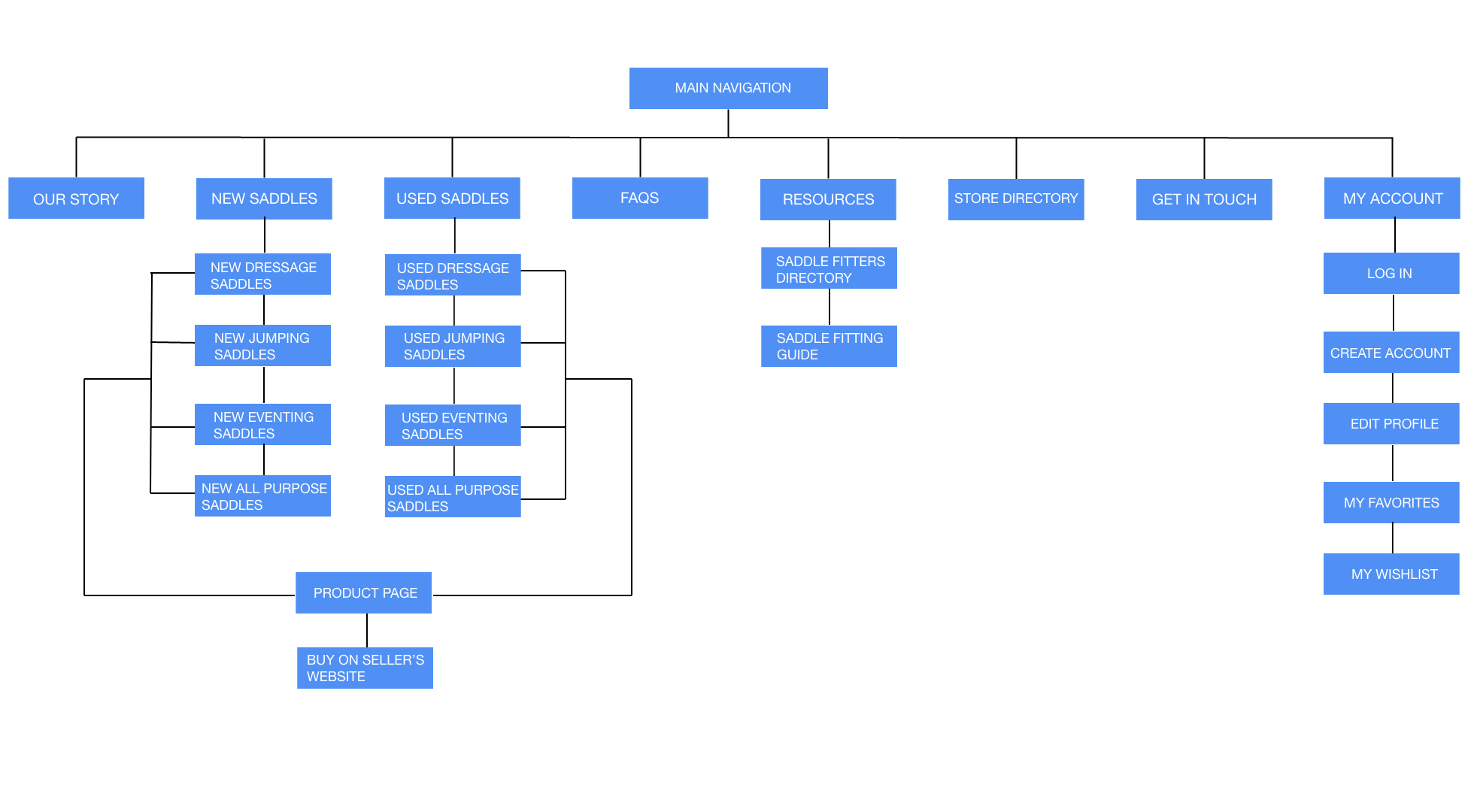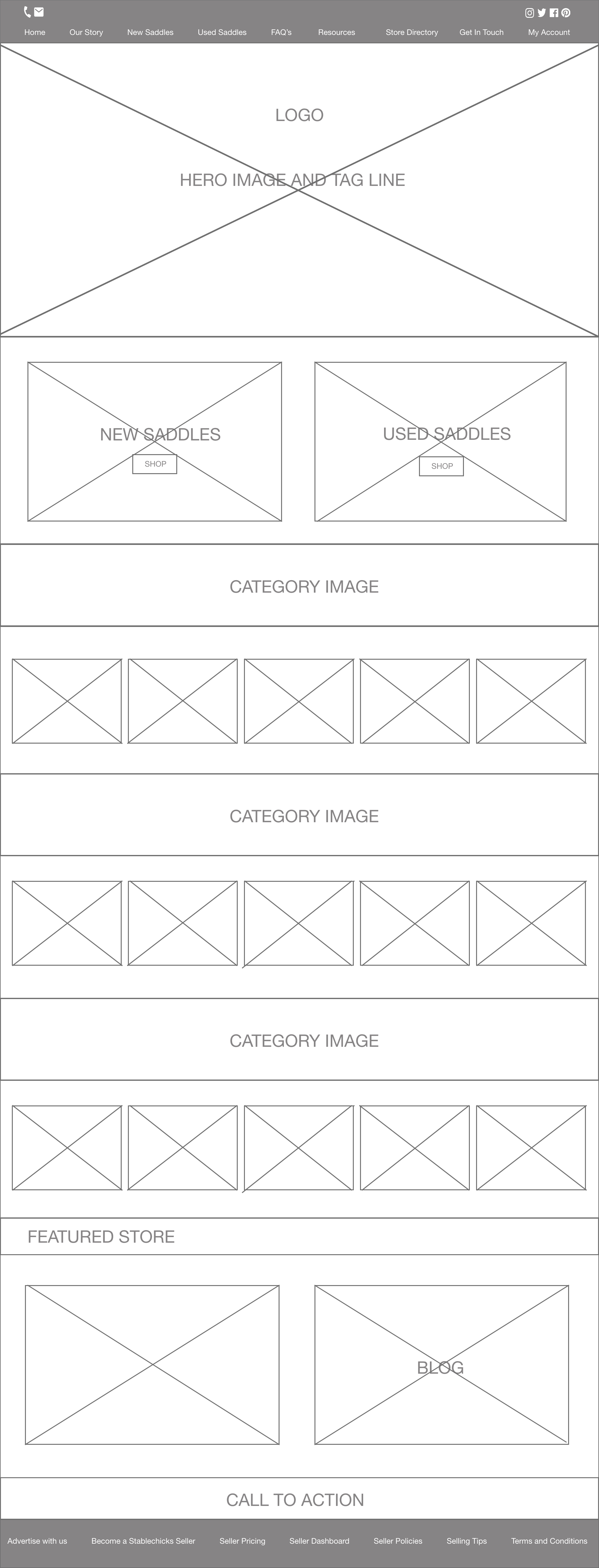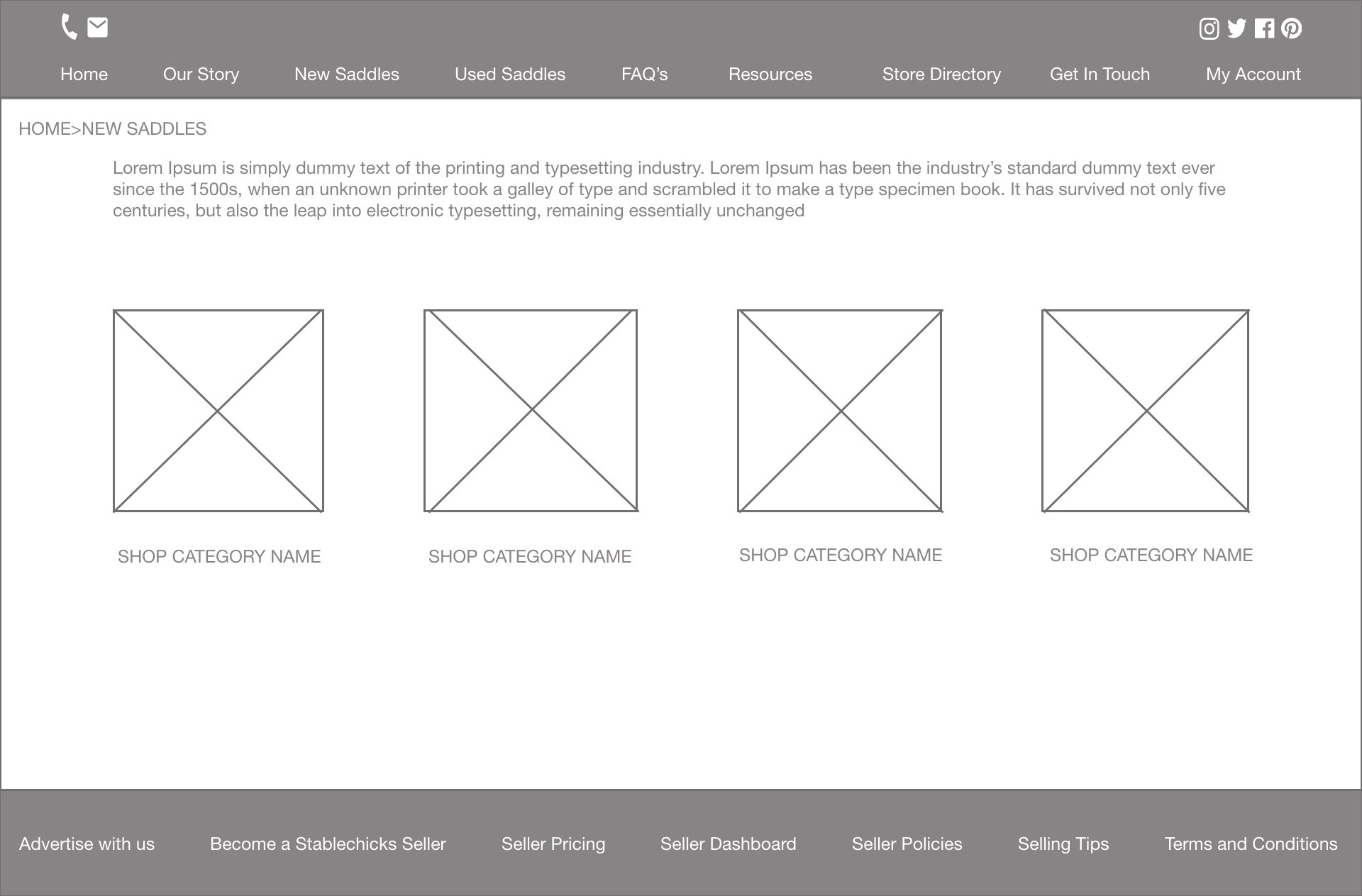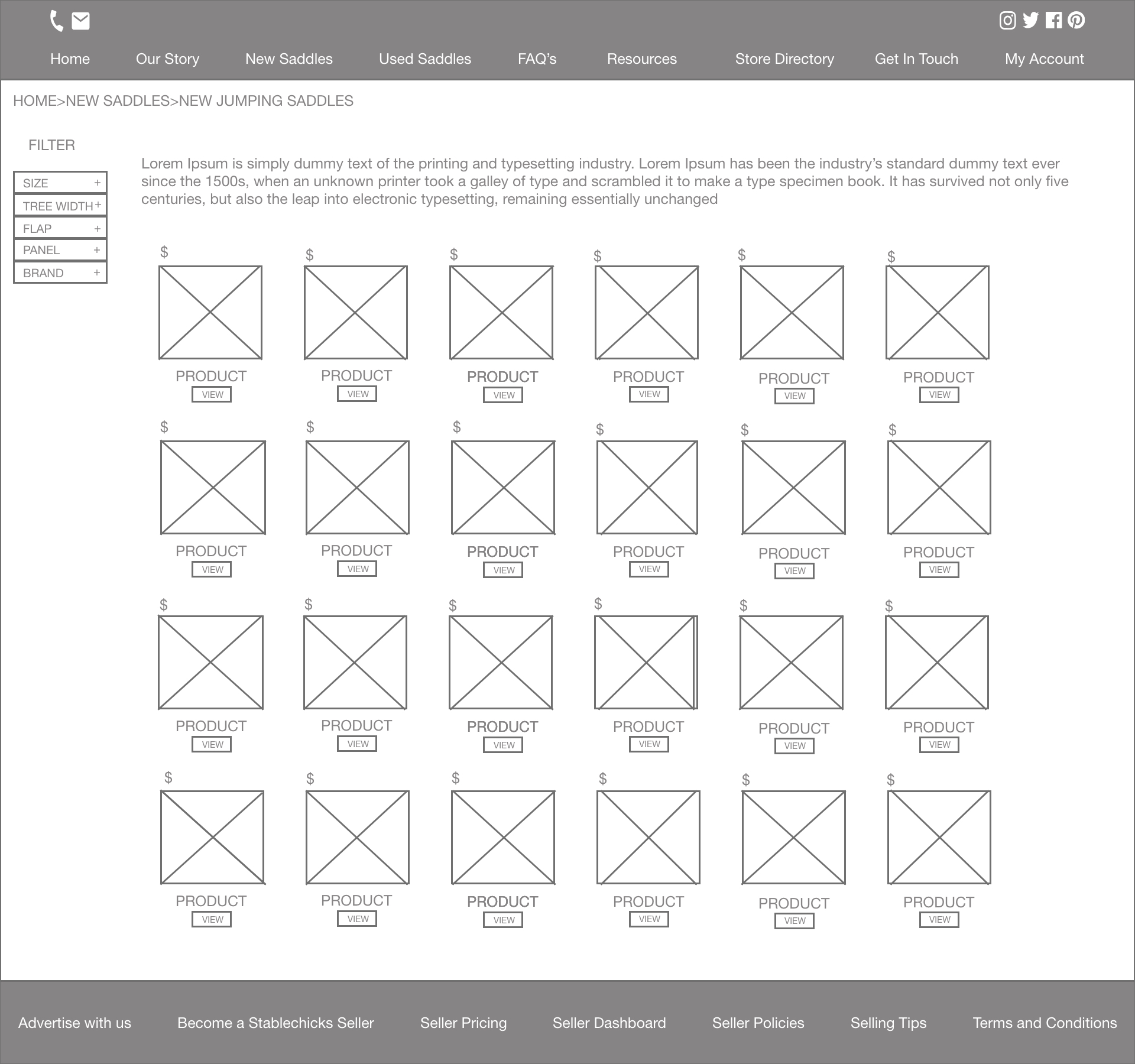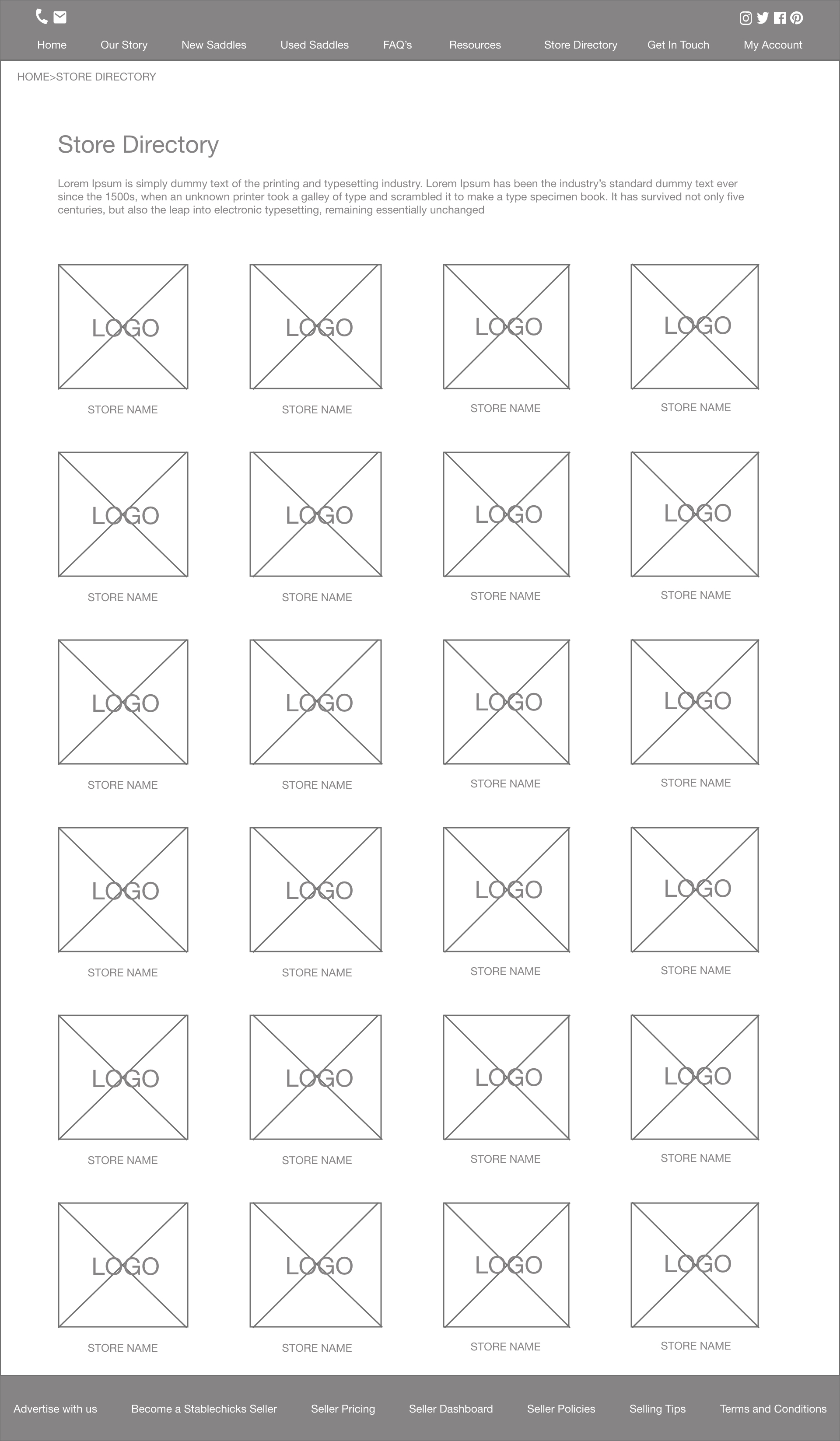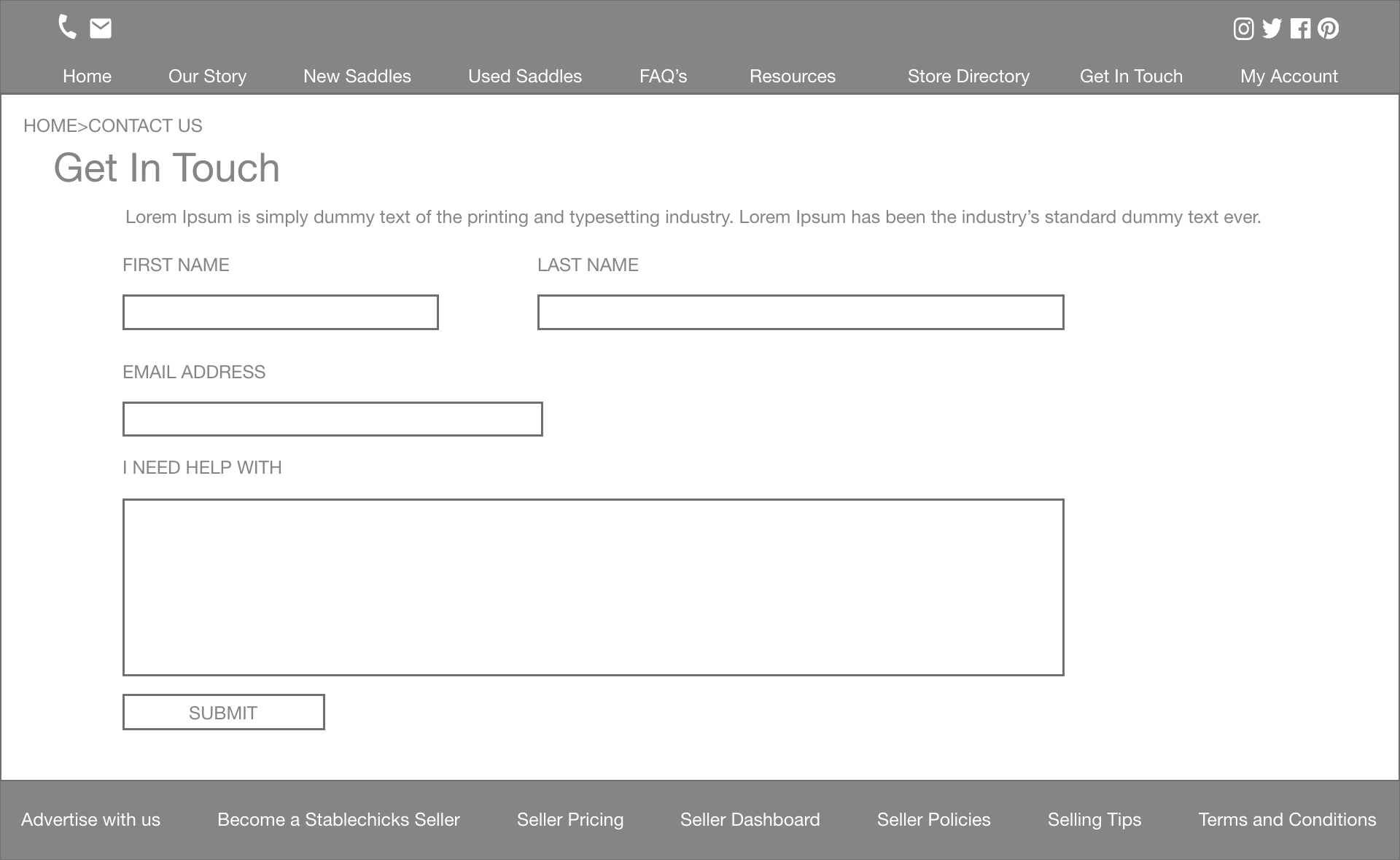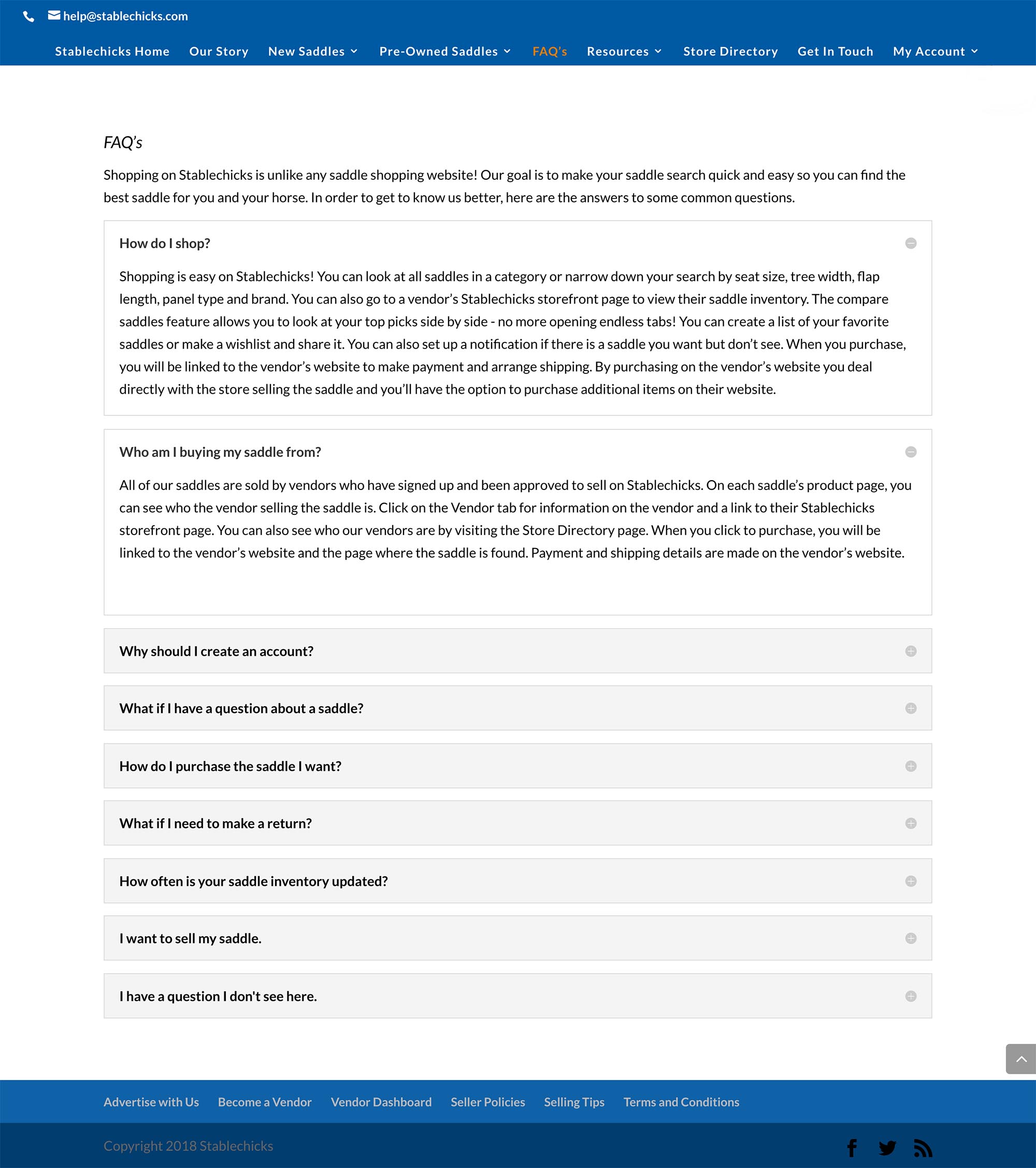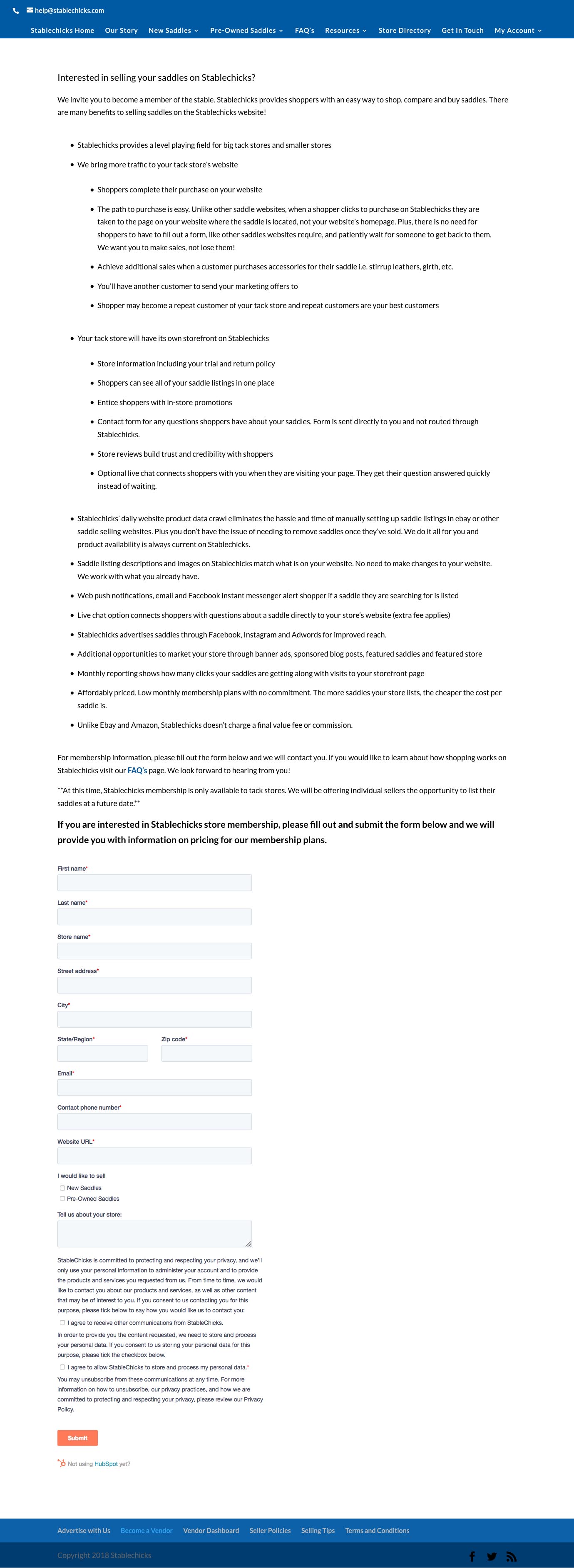
Stablechicks
Designed in 2018
A marketplace website for sales of high end used saddles
Highlights: E-Commerce Design, Research, Personas, Information Architecture, Wireframes, Visual Design, UX & UI Design, Content Writing
The Problem
Buying and selling saddles online is a frustrating experience. The buyer often has to visit several saddle websites to find what they are looking for. Information about a saddles can be vague or inaccurate. Some websites provide little product filtering options which can result in a time consuming search through dozens of saddles to find what the buyer is looking for. The majority of websites feature individual sellers, the major drawback being most sellers do not offer a trial period for the buyer to try the saddle on their horse to see if it fits, leaving the buyer stuck with a saddle they now need to sell.
Tack store owners have the difficulty of bringing shoppers to their website. Foot traffic is not what it used to be so stores are forced to rely more on internet sales to stay in business. While there are tack stores who make an investment in their website and marketing, the majority are small entities with only a few employees. They lack the time to market their saddles and may not have the technical expertise to list their saddle inventory on other websites like Ebay or Facebook. They are also competing with individual sellers and the perception that saddles are cheaper when purchased from an idividual because there is no commission added into the price.
The Solution
A shopping comparison website where tack store owners can list their inventory of both new and used saddles and shoppers can easily find the saddle they are looking for. Stablechicks does not have saddles from individual sellers. It gives tack stores the ability to reach more shoppers and it gives small stores the chance to sell alongside larger stores, thus leveling the playing field. Shoppers get the assurance that they are buying from a knowlegeable source and their purchase comes with a trial period so they can ride in the saddle and see if it fits their horse.
The Experience
To provide buyers with an easy to use website, that presents information clearly and provides an easy path to purchase. For tack stores, remove the difficulties of listing their saddle inventory through the use of automated product data scraping.
For shoppers:
- The ability to compare saddles side by side
- Many filtering options display the most targeted results
- Saddle information presented uniformly
- Saddles can be favorited, shared on social media and saved in a wishlist
- Easy path to purchase. Shopper clicks to purchase and goes directly to the URL of the saddle on the tack store’s website to complete the transaction.
- Can set an alert for when a particular saddle is in stock
- Reviews of tack stores provide an added layer of trust
For tack store owners:
- Saddle inventory data is scraped weekly and uploaded to Stablechicks. They can focus on running their business instead of spending hours doing it themselves.
- The sale takes place on their website and hopefully additional purchases during checkout.
- Live chat option allows store owners to connect directly with shoppers when they have a question
- Additional marketing opportunities through website banner ads and having saddles promoted on Stablechicks social media pages and in email.
My Responsibilities
- UX design
- Website design
- Discovery research
- Persona development
Tools
- WordPress
- Woocommerce
- CSS & HTML for theme customization
- Adobe Photoshop CC for image editing
- Adobe XD for wireframing

Competitor Research
I conducted in-depth research into who the major players in online saddles sales were. The three largest are Ebay, Facebook and Horseclicks. All three are well known and have a large number of saddles for sale. But how were these websites failing users?
The majority of sellers are individuals. Why is this a negative?
- There is little protection against possible fraud i.e. individual selling a stolen saddle.
- Information on a saddle may not be accurate.
- Individual sellers typically don’t offer returns or a trial period.
User experience was poor in the following ways:
- Sellers have to create each listing which is time consuming
- Limited filtering options means it takes longer for shoppers to find the right saddle.
- Both Horseclicks and Facebook require the buyer to contact the seller through email or instant messenger if they have a question or want to purchase. There is no way to purchase on their website.
- Saddles are just one of many products sold
- There is no way to compare different saddles
- It is often difficult to tell whether a seller is an Individual or tack store.
Click here for a more detailed version.
Persona Development
I spoke with several horse owners and surveyed 25 tack stores in order to better understand their needs. From the feedback I received, I developed personas for both shoppers and tack store owners.

Amanda
Age: 28
Job: Client services at an investment bank
Income: $85,000
Her problem: Most of the saddles she likes are sold by individuals that don’t allow returns.
Her story: Amanda is climbing the corporate ladder while paying off her student loan debt. She just bought a new horse and needs to buy a saddle for it. Price is a consideration for her and while she appreciates the quality and features of a $6,000 saddle, her budget won’t allow it so a used saddle from a premium brand makes financial sense to her.
What she says: ” I have a good job but, I’m still paying off my student loans so while I would love to buy the top of the line saddle that my barnmates have, a used saddle makes better financial sense. The problem with alot of the saddles I see listed is, it’s hard to know whether you are buying from an individual seller or a business. Most individual sellers won’t let you return the saddle if it doesn’t fit and I don’t want to get stuck with a saddle I have to sell. I’ve heard several stories of individuals selling stolen sadddles so I’m not sure I trust buying from them. To top it off, the way the websites are set up isn’t organized and I’m often forced to scroll through dozens of saddles to find what I want. It takes up a lot of my time when I could be out riding and caring for my horse.”
What is her goal: “I want to buy from a trusted and knowlegeable seller who will allow me to try the saddle out on my horse and return it if it doesn’t fit. It would be nice to find a website that has the saddles organized to make it easy to find what I want.”
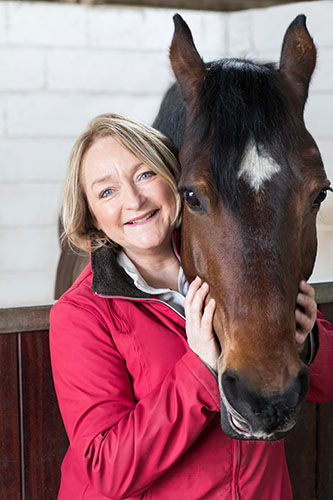
Betty
Age: 61
Job: Tack Store Owner
Income: $60,000
Her problem: She needs to get her saddle inventory in front of more buyers and get more sales.
What she says: “My business is struggling because of the online stores. Smaller tack stores are going out of business and I worry if that’s going to be me too. I used to have an active saddle consignment business with over 100 saddles, but I don’t have enough customers coming into the store to see them. I have them on my website but it doesn’t get much traffic. I looked at selling on Ebay but the fees were too high and I would have to hire someone to add the listings because I didn’t have time to do it myself. I need to find a solution before it’s too late.”
Her story: Betty has owned her tack store for 30 years and has seen alot change in that time. Like many retail tack stores, online stores have hurt her business as more of her customers prefer the convenience of online shopping over driving to her store. She has a website for her store, but her primary focus is her retail store. She would like to sell more saddles because they are a big ticket item but managing her retail store leaves her little time to devote to marketing them elsewhere.
What is her goal: “I would like to recapture some of the market share I lost to online stores. Saddles are my biggest ticket item and I would like to find a way to have them seen by more people, whether it’s on my website or somewhere else. I just don’t want it to be too expensive or time consuming to do.”
Click here for a more detailed persona description.
Site Architecture
I created page titles using keywords with an emphasis on typical search terms. Note: there is no cart because purchases take place on the seller’s website, not on Stablechicks.
Low- Fidelity wireframes for main pages
Key Learnings
What did users like about their experience?
- The clean layout of the website
- The number of filtering options that narrowed down their search to exactly what they were looking for
- An easy way to contact the store owner about a saddle they had questions on
- Interesting blog topics
- The website only focused on saddles
- Stores liked that they didn’t have to do anything to get their saddles listed because our web scraper did it for them
- Stores liked that they controlled the sale
- Stores liked that their saddles were promoted on social media
What could have been better?
- A number of live chat sessions with shoppers uncovered that they didn’t understand that the saddles were sold by a third party and not Stablechicks. I experimented with different product call to action buttons and “Buy on Seller’s Website” was the most effective.
- Some stores had trouble navigating from the “Seller Pricing” page to the “Become a Seller” page.
- Having more images of each saddle instead of just one featured image. Much of this had to do with the way the WordPress media library is designed. Even if an image was deleted, a copy of it and all of the image thumbnail sizes remained on the server. It quickly became very cumbersome to manage unless images were manually deleted.
- While the goal was to scrape the store websites daily for inventory changes, technology was a blocker. The data scrape was to essentially have live inventory levels for each store so that saddles shown on Stablechicks matched what was available on a seller’s website. This feature was integral to the user’s experience but, to do this required an initial scraper to be developed in order to create a starting inventory and then a second scraper developed with the ability to compare current inventory against starting inventory. To develop this capability was cost prohibitive because there wasn’t enough of a market to spread the cost among stores. While the responsibility could be given to the tack stores to maintain their listings on Stablechicks, this removed what was to be a major selling point and essential to the seller’s user experience.
Final Thoughts
There were high hopes for Stablechicks. It was clearly filling a gap, based on discovery research and initial feedback from buyers and tack stores. The challenge was trying to grow buyers and sellers at the same time. It was like the chicken and the egg; stores wanted to know that there was the customer base to justify the price but in order to have buyers, you have to have inventory. Tack store owners were excited about the concept but even with a free trial and competitive pricing, when the site went live, they were hesitant to sign on.
In the end, it was decided the concept wasn’t going to be financially viable but it was an incredible learning experience taking an idea and designing it from concept to launch.

